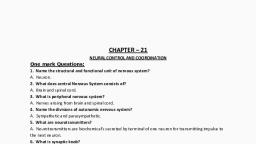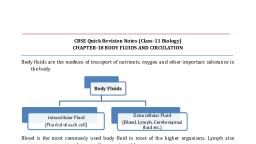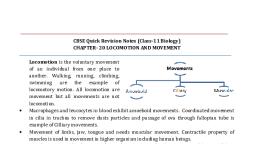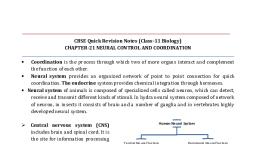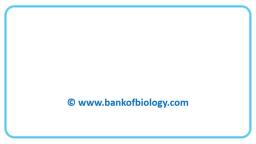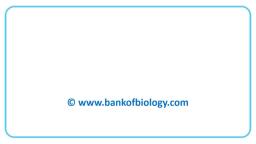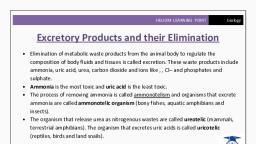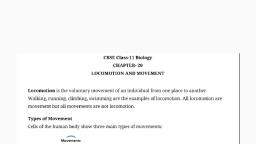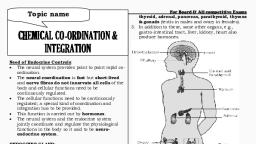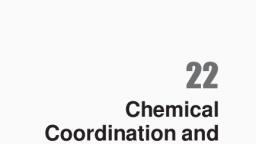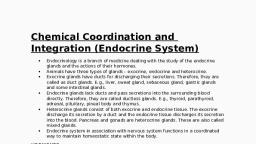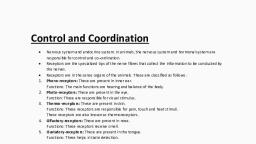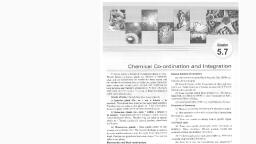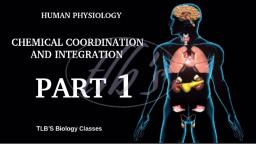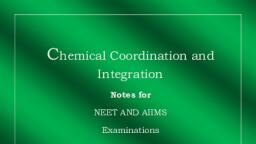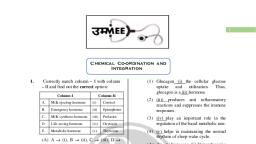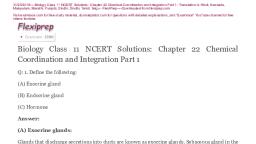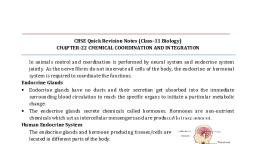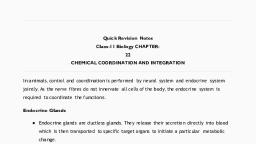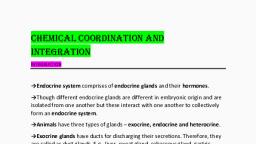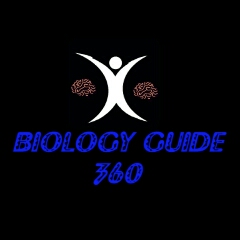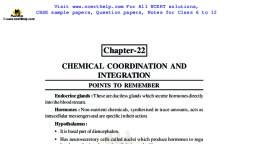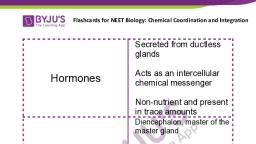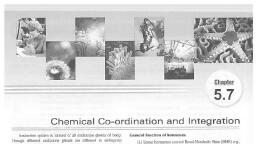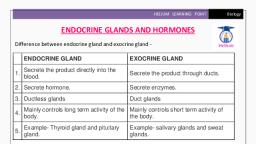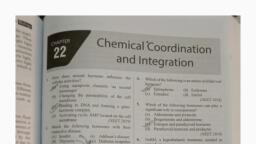Page 1 :
22, Chemical, Coordination and, Integration, Glands, They are the group of cells that are specialised for the secretion of a, particular substance. They can be classified as follows, , Types of Glands, 1. Exocrine glands The secretion of these glands are carried by, the ducts to a particular organ, e.g., salivary glands, liver, etc., 2. Endocrine glands These glands do not possess ducts and they, pour their secretions directly into the blood, e.g., hypothalamus,, thyroid, etc., (i) Holocrine glands They secrete only hormones, e.g., thyroid,, adrenal, etc, (ii) Heterocrine glands They have dual functions, i.e.,, secretion of hormones and other physiological functions, e.g.,, testes, pancreas, etc., , Hormones (Bayliss and Starling; 1903), These are the chemical substances that are produced or released by, cells or group of cells that form the endocrine (ductless) glands., Target cells are the cells affected by a hormone. These target cells are, selective or exclusive to a hormone due to the presence of protein, receptors on them.
Page 2 :
Chemical Coordination and Integration, , 361, , Types of Hormones, (i) Hormones fall into two broad categories, (a) Tropic hormones These hormones stimulate other, endocrine glands to produce and secrete hormones,, e.g., Thyroid Stimulating Hormone (TSH) produced by, pituitary gland stimulates the release of thyroxine, hormone from thyroid gland. Thyroxine in turn stimulates, metabolism in many types of body cells. Thus, TSH is a, tropic hormone (thyroxine is a non-tropic hormone)., (b) Non-tropic hormones These hormones stimulate vital, cellular processes including metabolism, but do not, stimulate the release of other hormones, e.g., prolactin, secreted by anterior pituitary stimulates the production of, milk in a woman’s breast tissue., (ii) According to their chemical composition, hormones can be, classified into following groups, (a) Steroid hormones Derivative of cholesterol, e.g.,, aldosterone, cortisol, sex corticoids, oestrogen, etc., (b) Proteins and peptide hormones Largest group of, hormones, they are the long chains of amino acids,, e.g., insulin, hCG, hypothalamic hormones, GH, etc, (c) Amine hormones Smaller molecules derived from, amino acid tyrosine, e.g., thyroxine, catecholamines, etc., (iii) Local hormones These are secreted by the cells, but not by, glands and widely dispersed in the body. These are considered, as tissue hormones or non-endocrine hormones., Different types of local hormones are as follows, (a) Histamine Synthesised by mast cells in tissues and, basophils, released in response to inflammation, increases, capillary permeability and dilation., (b) Leukotrienes Released from mast cells, assist in promoting, allergic response cause vasoconstriction, attract neutrophils, to the site of inflammation present in large quantity in, rheumatoid joints., (c) Cytokines Polypeptide hormones, help in defence, mechanism, elicit effects on same cells and nearby cells,, important cytokines are interleukins and interferons., (d) Thromboxanes Synthesised by platelets, cause, vasoconstriction and platelet aggregation, thus contribute to, the process of blood coagulation.
Page 3 :
362, , Handbook of Biology, , Human Endocrine System, Neurosecretory neurons, of hypothalamus, , Anterior, pituitary, Venous, outflow, , Capillary bed, Hypophyseal, Vein, Portal, Capillaries in, System, anterior pituitary, An anatomical connection, Posterior, between nervous, endocrine, pituitary, and circulatory system., , 1_,, , Arterial, inflow, , Pituitary Gland, Master gland of the body, lying in hypophysial, fossa or sella turcica, contains two parts,, i.e., adenohypophysis (anterior) and, neurohypophysis (posterior). Adenohypophysis, is formed from embryonic buccal, cavity (Rathke’s pouch) and neurohypophysis, develops from diencephalon., , Parathyroid, These are the four small nodules of, tissue embedded in the back side of, thyroid gland; develop as epithelial buds, from third and fourth pairs of pharyngeal, pouches, contain chief (principal) cells, which secrete hormones and oxyphil, (eosinophil) cells which are considered, as degenerated chief cells. Its hormones, are called parathormones, or collips hormone., , Adrenal Gland, Perched on top of the kidneys;, consists of an inner medulla and, outer cortex, each of which releases, several hormones. Its cortex region is, mesodermal in origin, whereas, medulla is ectodermal., Medulla secretes emergency, (or flight or fight) hormones., , Pancreas, Dual purpose organ, produces, digestive enzymes and hormones,, its acini meets the exocrine, functions, whereas Islet of, Langerhans perform, endocrine functions.
Page 4 :
Chemical Coordination and Integration, , 363, , Pineal Body, Also called epiphysis,located on the dorsal, side of forebrain; it is stalked, small, rounded, and redish–brown gland, secretes hormones, like melatonin (derivative of tryptophan) and, neurotransmitters like serotonin, histamine,, somatostatin, etc., , Hypothalamus, Contains neurosecretory cells (nuclei), that produce hormones to control the, pituitary functioning. It synthesises both, tropic and inhibitory hormones., , Thyroid Gland, Contains follicles which synthesise hormones., The follicles are formed of cuboidal epithelial, cells, secrete 3 hormones namely triiodothyronin, (T3), thyroxine (T ) and calcitonin., , Thymus Gland, Endodermal origin, develops from, the epithelium of outer part of third, gill pouch, lobular structure lying on, dorsal side of the heart and aorta,, contains lymphoid tissues that take, part in proliferation and maturation of, T-lymphocytes and release peptide, hormones that are referred to as thymosins, (humoral factors) and are important during, puberty., , Testes, Male gonad, perform dual functions,, i.e., synthesise sperms and release, hormone, their hormones are called, androgens., , Ovaries, Female gonad, perform dual, functions, i.e., production of, ova and hormone release.
Page 5 :
364, , Handbook of Biology, , Major Hormones of Human Endocrine System, Gland, Hypothalamus, , Hormone, , Type, , Action, , Oxytocin, , Peptide, , Moves to posterior pituitary for, storage., , Antidiuretic Hormone, (Vasopressin), , Peptide, , Moves to posterior pituitary for, storage., , Regulatory Hormones, (RH and IH) of, anterior pituitary gland, , Act on anterior pituitary to, stimulate or inhibit the, hormone production., , Pituitary gland, Anterior, (i) Pars distalis, , Growth Hormone (GH) Protein, , Stimulates body growth., , Prolactin, , Protein, , Promotes lactation., , Follicle-Stimulating, Hormone (FSH), , Glycoprotein Stimulates follicle maturation, and production of oestrogen;, stimulates sperm production., Glycoprotein Triggers ovulation and, production of oestrogen and, progesterone by ovary,, promotes sperm production., , Luteinizing Hormone, (LH), Thyroid-Stimulating, Hormone (TSH), , Glycoprotein Stimulates the release of T3, and T4., , Adrenocorticotropic, Hormone (ACTH), , Peptide, , Promotes the release of, glucocorticoids and androgens, from adrenal cortex., , (ii) Pars, intermedia, , Melanocyte-Stimulating Peptide, Hormone (MSH), , Maintenance of lipid content in, body., , Posterior, , Oxytocin Vasopression, (ADH), , Peptide, , Initiates labor, initiates milk, ejection, controls osmotic, concentration of body fluids in, particular water reabsorption, by kidneys., , Thyroid gland, , T3 (Triiodothyronine), , Amine, , Increases metabolism and, blood, pressure, regulates, tissue growth, five times more, potent than T4., , T4 (Thyroxine), , Amine, , Increases metabolism and, blood pressure, regulates tissue, growth., , Calcitonin, , Peptide, , Childhood regulation of blood, calcium levels through uptake, by bone.
Page 6 :
Chemical Coordination and Integration, Gland, , Hormone, , Type, , 365, , Action, , Parathyroid, gland, , Parathyroid hormone, (parathormones or collip, hormones)., , Peptide, , Increases blood calcium, levels through action on, bone, kidneys and intestine., , Pancreas, , Insulin (-cells), , Protein, , Reduces blood sugar level, by regulating cell uptake., , Glucagon (-cells), , Protein, , Increases blood sugar levels., , Adrenal glands, , Epinephrine, , Amine, , Adrenal medulla, , (Adrenaline), , Affects PNS either by, stimulating or inhibiting it,, increases respiration rate,, heart rate and muscle, contraction., , Amine, , Stress hormone, increases, blood pressure, heart rate, and glucose level., , Glucocorticoids (cortisol), , Steroid, , Long-term stress, response–increased blood, glucose levels, blood volume, maintenance, immune, suppression., , Mineralocorticoids, (Aldosterone), , Steroid, , Long-term stress, response-blood volume and, pressure maintenance,, sodium and water retention, by kidneys., , Norepinephrine, (Nor-adrenaline), Adrenal cortex, , Gonads, Testes, , Androgens (Testosterone) Steroid, , Reproductive maturation,, sperm production., , Ovaries, , Oestrogen, , Steroid, , Stimulates hypothalamus to, release GnRH before, ovulation, maintains, follicular growth., , Progesterone, , Steroid, , Maintains pregnancy and, uterus wall thickening,, inhibits the release of, oestrogen., , Pineal gland, , Melatonin, , Amine, , Circadian timing (rhythm)., , Thymus, , Thymosin, , Peptide, , Development of, T-lymphocytes.
Page 7 :
366, , Handbook of Biology, , Mechanism of Hormone Action, Hormones are mainly of two types, i.e., water soluble (e.g., amino, acid derivatives, peptide and protein hormones) and lipid soluble, (e.g., steroid hormones)., Water soluble hormones require extracellular receptors and generate, second messengers (e.g., cAMP) for carrying out their activity., Lipid soluble hormones can pass through cell membranes and directly, enter the cell., (i) Steroid Hormone Action through Intracellular Receptors, These hormones easily pass through the cell membrane of a target cell, and bind to specific intracellular receptors (protein) to form a hormone, receptor complex., , Uterine cell, membrane, Hormone, (e.g., oestrogen), , 2 Hormone-receptor, complex binds to, transcription factor, Nucleus which further binds, to DNA., , Genome, 1 Steroid hormone, binds to receptor, to form receptor, hormone complex, in the nucleus., , Proteins, , 4 Physiological responses, like tissue growth and, differentiation are elicited., , 3 A particular gene, is activated and, Receptor-Hormone Complex, transcribed., , Mechanism of steroid hormone action, , (ii) Peptide Hormone Action through Extracellular Receptors, These hormones act at the surface of target cell as primary, messengers and bind to the cell surface receptor forming the, hormone-receptor complex., This mechanism was discovered by EW Sutherland in 1950 for which, he got the Nobel Prize.
Page 8 :
Chemical Coordination and Integration, , 367, , Adrenaline Hormone, 1 Binding of hormone to receptor, form hormone receptor complex., Membrane, , Adrenaline Receptor, , , G-Protein, , GDP, , 2 Hormone receptor, complex induces the GDP, release of GDP to from, G-protein which releases, and subunits of, G-Protein., 5 cAMP molecules bind to, inactivated protein kinase, A and activate it., , , , , , , Extracellular, , , , , , 3 and subunits, activate the, adenyl cyclase., ATP, , Protein Kinase A, (inactive), , GTP, , Activated Adenyl, Cyclase, 4 Activated adenyl cyclase, catalyses the formation of, cAMP from ATP., , Protein Kinase A, (active), , 6 Every activated, Phosphorylase Kinase, molecule, (inactive), Phosphorylase Kinase activates, (active), inactivated, Glycogen, molecules, Phosphorylase, (Cascade effect)., (inactive), Glycogen Phosphorylase, (active), , Glycogen, 7 Activated glycogen phosphorylase, convert glycogen to glucose-1 phosphate, which changes to glucose, , Glucose, , Membrane, , Cytoplasm, , Glycose-1, Phosphate, , Outside, , Mechanism of protein hormone action, , Hence, single molecule of adrenaline may lead to the release of, 100 million glucose molecules., , Regulation of Hormone Action, Both hypoactivity and hyperactivity of an endocrine gland produces, structural or functional abnormalities. Hence, the normal functioning, of endocrine glands and the level of hormones in the body needs to be, regulated.
Page 9 :
368, , Handbook of Biology, , This is possible by feedback mechanisms. Feedback mechanism, works on a simple principle that a hormone will be synthesised only, when it is needed. Thus, feedback mechanism may be positive or, negative and may operate in following ways, , 1. Feedback Control by Hormones, The hyposecretion of a hormone is sometimes dependent upon the, hormones secreted by other glands. For example, hypothalamus is, stimulated by some external stimulus and produces releasing, hormones., 2. Feedback Control by Metabolites, The levels of metabolites also affect the secretion of certain hormones., For example, after a meal, glucose level of blood rises which stimulates, secretion of insulin to act on it., 3. Feedback Control by Nervous System, An emotional stress stimulates the sympathetic nervous system. In, turn, sympathetic nerves of adrenal gland stimulate adrenal medulla, to produce adrenaline hormone. This leads to increase in blood, pressure, heartbeat and rate of respiration., , Control of Hormone Action, Hormones help to control many homeostatic mechanisms. Their, production and release are generally controlled by positive or negative, feedback loop., ◆, In positive feedback loop, hormones released by one gland, stimulate the other gland which further leads to even more, significant changes in the same direction. It acts as self-amplifying, cycle that accelerates a process., ◆, While in negative feedback loop, the end product of a biochemical, process inhibits its own production.
Page 10 :
Chemical Coordination and Integration, , 369, , Endocrine Disorders, (i) Acromegaly It is caused by the hypersecretion of GH after, bone growth has stopped., Its symptoms include skin and tongue thickening, enlarged, hands and feet, facial features become coarse., (ii) Addison’s disease It is caused due to the decreased, production of hormones from adrenal gland usually due to, autoimmune reactions., Its symptoms include loss of weight and appetite, fatigue,, weakness, complete renal failure., (iii) Cushing’s syndrome It is caused due to the hyposecretion of, hormones from adrenal glands., In this disease, face and body become fatter, loss of muscle mass,, weakness, fatigue, osteoporosis., (iv) Cretinism (Hypothyroidism) The retarded mental and, physical development is associated with the hyposecretion of, thyroid hormones. The child receives hormones from the mother, before birth, so appears normal at first, but within a few weeks, or months it becomes evident, the physical and mental, development are retarded., Symptoms are disproportionately short limbs, a large, protruding tongue, coarse dry skin, poor abdominal muscle tone, and an umbilical hernia., (v) Diabetes insipidus It is caused due to the hyposecretion of, ADH and characterised by excessive thirst, urination and, constipation., (vi) Diabetes mellitus It is caused due to the insufficient insulin, production in body. It can be of two types, i.e., Type 1 or Insulin, Dependent Diabetes Mellitus (IDDM) and Type 2 or NonInsulin Dependent Diabetes Mellitus (NIDDM)., It is characterised by poor wound healing, urinary tract, infection, excess glucose in urine, fatigue and apathy., (vii) Eunuchoidism It is a hormonal disorder due to the deficient, secretion of testosterone in males. In this case, the secondary, male sex organs, such as prostate gland, seminal vesicle and, penis are underdeveloped and non-functional. The external, male sex characters like beard, moustaches and masculine voice, fail to develop, sperms are not formed.
Page 11 :
370, , Handbook of Biology, , (viii) Grave’s disease (Hyperthyroidism) It is caused due to the, hypersecretion of thyroxine., Its symptoms include protrusion of eyeballs (exopthalamus),, excessive fat near the eyes, weight loss, nervousness, excess, sweating., Toxic nodular goitre (Plummer’s Disease) It is caused due, to the excess secretion of T 3 and T4 and is characterised by the, presence of glandular tissue in the form of lumps., Simple goitre It is caused due to the deficient secretion of T3, and T4 hormones which results in the enlargement of thyroid, gland., (ix) Gigantism It is caused by the excess of growth hormone from, early age. It is characterised by large and well-proportioned, body., (x) Gynaecomastia It is the development of breast tissue in, males. Gynaecomastia occurs mainly due to the disturbance in, oestrogen and testosterone ratio., (xi) Hyperparathyroidism It is caused due to the excessive, parathromones secretion usually due to tumour in parathyroid, gland., Its symptoms include kidney stones, indigestion, depression,, loss of calcium from bones, muscle weakness., (xii) Hypoparathyroidism (Tetany) It is caused due to the, hyposecretion of parathyroid hormones., Its symptoms include muscle spasm, dry skin, numbness in, hands and feet., (xiii) Hypogonadism It occurs due to the defect in hypothalamus,, pituitary, testes or ovaries. In males, less production of, testosterone occurs affecting the development of male secondary, sexual features. In females, deficient production of oestrogen, occurs resulting in very less development of secondary sex, characters., (xiv) Simmond’s disease It is caused due to the atrophy or, degeneration of anterior lobe of pituitary gland. In this disease,, the skin of face becomes dry and wrinkled and shows premature, ageing.
